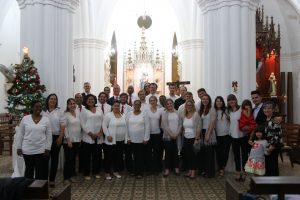Musik als Mittlerin der Kulturen
Die Kubareise eines Chors aus Montana
Kirk Aamont, außerordentlicher Professor für Musik an der staatlichen Universität Montana
Die tiefe, dauerhafte Sehnsucht nach zwischenmenschlichem Kontakt ist allen Menschen gemein, aber leider nicht immer einfach zu stillen. Wenn man dies trotzdem versucht, gilt es, viele Hindernisse zu überwinden. Musik hat die Kraft, große kulturelle Differenzen zu überbrücken. Musik kann Verbundenheit zwischen Menschen verschiedenster Kulturkreise schaffen. Die Liebe zur Musik vereint Menschen und kann der fruchtbare Boden sein, auf dem lebenslange Freundschaften entstehen.
Die Liebe zur Musik hat kürzlich 14 Collegestudent*innen aus Bozeman (Montana) mit 12 Chorsänger*innen aus Havanna (Kuba) in einem gemeinsamen Chorprojekt zusammengebracht und damit den Grundstein für eine tiefe Freundschaft gelegt. Dennoch zeigte sich in der ersten gemeinsamen Probe schnell, dass unsere unterschiedlichen Ansätze, Musik zu machen, sich als Hindernis auf dem Weg zur Gemeinschaft herausstellten.
Musik kann kulturelle Unterschiede überwinden und Verbundenheit schaffen – aber anfangs standen uns unsere unterschiedlichen musikalischen Ansätze dabei im Weg und verhinderten ein Miteinander.

Mitglieder der “Montanans” von der MSU auf der Anreise zu ihrem Konzertort in Havana. Photo: Hailey Maurer Photography
Im November 2018 hatte unser Chor die Ehre, von Erzbischof Juan Garcìa Rodriguez nach Havanna eingeladen zu werden. Die Gestaltung eines Weihnachtskonzerts in der Kathedrale von Havanna sollte ein Programmpunkt unserer achttägigen Kubareise sein. Royce Smith, Dekan des College of Arts and Architecture an der staatlichen Universität von Montana war dabei behilflich, die Einladung festzumachen.
Es war uns eine besondere Ehre, in der Kathedrale auftreten zu dürfen. Zu diesem Anlass – sowie für drei weitere Konzerte – taten wir uns mit Artes de Cortes zusammen, dem Chor der Pfarrei Nuestra Señora del Carmen unter Sylvia Ponce. Unsere Chöre sollten jeweils am Ende der Konzerte zusammen singen, und Sylvia und ich sprachen uns bezüglich des Programms miteinander ab. Angekommen in Havanna merkten wir bei Probenbeginn schnell, dass es notwendig sein würde, unsere unterschiedlichen Ansätze beim Proben in Einklang zu bringen, um zu einem gemeinsamen Ensemble zusammenzuwachsen. Unsere Sänger*innen waren deutlich unterschiedliche Probenstile gewohnt. Für die Student*innen aus Montana ist Musik in erster Linie ihr Studienfach. Oberste Priorität hat deshalb die notentextgetreue Wiedergabe der Musik. Sie singen wahnsinnig gerne und sind dabei in den Konzerten immer ausdrucksvoll und authentisch. Ihr vorrangiges Ziel ist jedoch die Notentexttreue. Hinzu kommt, dass sie im Gegensatz zu Artes de Cortes nicht im Gottesdienst auftreten. Sie studieren Musik aus unterschiedlichen Kulturkreisen und Epochen ein, um sie zum Selbstzweck in einem Konzert aufzuführen. Sie bewerten ihre eigene musikalische Leistung kritisch und möglichst objektiv. Dabei sind sie aber keineswegs leidenschaftslos: in ihrem Studium haben sie gelernt, ihre Leistung nach Kriterien der stil- und notentextgetreuen Wiedergabe zu beurteilen. Wird eines dieser beiden Kriterien nicht erfüllt, sind sie nicht zufrieden. Es fiel uns auf, dass für die kubanischen Sänger*innen Musik in erster Linie einen sozialen Zweck hat – sie möchten Verbundenheit mit den Mitsänger*innen und dem Publikum spüren. Sie mögen ihre Zusammenkünfte und das gemeinsame Singen und möchten diese Freude an der Musik und Gemeinschaft auch dem Publikum vermitteln. Die Musikstücke, die der Chor singt, lernen die kubanischen Sänger*innen meistens durch Hören, gegenseitiges Vorsingen und den Austausch darüber, was die Musik sagen will. Sie singen sich gegenseitig die zu lernenden Partien vor. Sylvia hatte zwar Noten dabei, aber die meisten Sänger*innen lernten durch Hören und Wiederholen. Dabei kam manchmal etwas heraus, was nicht in den Noten stand. Ob sie probten oder auftraten – die Musik einte sie. Das gemeinsame Ziel schuf ein starkes Gemeinschaftsgefühl. Anders als die Collegestudent*innen tritt der kubanische Chor immer zu einem bestimmten Anlass auf. Ihr Ziel ist es, gemeinsam etwas einzustudieren, um den Gottesdienst damit zu verschönern.
Als wir Planungsgespräche führten, war Sylvia und mir durchaus bewusst, dass unsere Chöre unterschiedliche Probenstile gewöhnt waren. Dennoch konnten wir zu diesem Zeitpunkt noch nicht ahnen, wie eingefahren die unterschiedlichen Lernstile unserer Sänger*innen tatsächlich waren, und wie lange jede Gruppe brauchen würde, Kompromisse im Dienst des gemeinsamen Singens einzugehen. Es war mir nicht bewusst, wie wichtig für meine Student*innen Genauigkeit war, um sich bestätigt und erfolgreich zu fühlen, und wie schwierig es für sie sein würde, eine andere Perspektive einzunehmen. Sylvia war es nicht in vollem Maße bewusst, wie wichtig es ihren Sänger*innen war, dass die Student*innen die Stücke von ihnen lernten, ohne sich in erster Linie auf die Noten zu verlassen.
„Die Musik ist nicht auf diesem Blatt Papier, auf das ihr schaut.“ Dieses Statement von Sylvia war der Beginn eines Verständigungsprozesses zwischen den zwei Chören.
Schon am ersten Abend des Zusammentreffens waren die musikalischen Differenzen zwischen den Sänger*innen greifbar gewesen. Wir kamen früh in der Kirche an, um vor der Ankunft der Kubaner*innen noch ein wenig alleine zu proben. Wir arbeiteten zuerst an dem Stück, das wir zusammen mit Sylvias Chor singen würden. Alle Student*innen hatten eine Partitur vor sich und einen Bleistift in der Hand, mit dem sie fleißig Einträge machten. Als die Sänger*innen von Artes de Cortes eintrafen, wurde die Probenarbeit für die Student*innen zur Herausforderung. Nicht alle kubanischen Sänger*innen sangen von Noten. Deshalb waren sich die Sänger*innen in jeder Stimmgruppe nicht hundertprozentig einig darüber, wie das Stück ging. Bei manchen kadenzierenden Wendungen sangen die Sänger*innen derselben Stimme beim Schlussakkord unterschiedliche Töne. Manche Sänger*innen verzierten die Melodie, andere nicht. Einmal passierte es, dass ein Bass die Melodie eine Oktave unter den Sopranen sang. Diese kleinen Abweichungen wurden von allen akzeptiert und gehörten zu ihrem Musikmachen. Für die Student*innen aus Montana jedoch war es kaum zu verstehen, dass diese kleinen Ungenauigkeiten einfach hingenommen und nicht konsequent korrigiert wurden. Einheitlichkeit stand für Sylvia und ihre Sänger*innen eben nicht im Vordergrund – Gemeinschaft und Lobpreis durch Musik war für sie am wichtigsten. Als Sylvia merkte, wie wichtig es für ihre Sänger*innen war, mit ihren Gästen musikalisch eins zu werden, und dass dabei die Partituren im Weg standen, sagte sie etwas, das vielleicht dazu führte, dass die beiden Chöre zu einem Ensemble zusammenwuchsen. Sie bat um Aufmerksamkeit und teilte den Student*innen mithilfe eines Dolmetschers mit, dass „die Musik nicht auf diesem Blatt Papier ist, auf das ihr schaut“. Dieses Statement war der Beginn eines Verständigungsprozesses zwischen den zwei Chören.
Von diesem Moment an versuchten meine Student*innen, sich auszusöhnen mit dem Widerstreit zwischen notierter Musik und dem, was sie von den kubanischen Sänger*innen hörten. Sylvias Sänger*innen spürten, dass ihre neuen Freunde irritiert waren, und sie schienen sich zu fragen, weshalb die Student*innen immer in die Noten starrten statt sich an ihnen zu orientieren. Die Sänger*innen von Artes de Cortes wollten den Student*innen ihre Auffassung von Musik nahebringen, ob dies nun so in den Noten stand oder nicht. Um diese unterschiedlichen Ansätze einander anzunähern, mussten die Student*innen aufhören, die Noten als einzig gültige Orientierung anzusehen und beginnen, mit den kubanischen Sänger*innen zu kooperieren. Als sie dies taten, war der erste Schritt in Richtung Verständigung gemacht.
Als die Student*innen nach und nach das genaue Singen nicht mehr im Mittelpunkt sahen, sondern den Fokus auf das gemeinsame Singen mit ihren kubanischen Freunden verlagerten, fand eine natürliche und wichtige Veränderung statt.
Die Student*innen verschoben ihren Fokus langsam von den Noten auf die kubanischen Chormitglieder. Einer nach dem anderen legte seine Noten beiseite und mischte seine Stimme mit denen der kubanischen Sänger*innen. Sie lauschten, wiederholten Abschnitte, lächelten, lachten und wurden langsam zu einer singenden Gemeinschaft. Mitglieder des kubanischen Chors griffen den Student*innen helfend unter die Arme; sie berührten sie an Armen und Schultern wenn sie ihnen die Partien vorsangen – während sie diejenigen Stellen betonten, die anders gesungen wurden als notiert. Der Lernwille der Student*innen ermutigte die kubanischen Sänger*innen sehr. Jetzt, wo die Noten weggelegt worden waren und sie die volle Aufmerksamkeit der Student*innen hatten, begannen sie wirklich zusammen zu musizieren.
Sehr zur Freude des kubanischen Chors hatten die Student*innen ihre Partien schnell gelernt. Der Klang ihrer Stimmen feuerte den Enthusiasmus und die Leidenschaft des kubanischen Chors an; Sylvia und ich genossen in vollen Zügen die wunderbare Gemeinschaft, die entstanden war.
Als unsere gemeinsame Zeit zu Ende ging, hatten die Student*innen und die Mitglieder von Artes de Cortes durch Musik viel mehr erreicht als nur ein Ensemble zu bilden. Es war der Anfang einer echten Freundschaft. Unsere unterschiedlichen methodischen Prioritäten beim Proben waren anfänglich hinderlich, aber letztendlich half das gemeinsame Singen dabei, zu einer Gemeinschaft zusammenzuwachsen. Um die unterschiedlichen probenmethodischen Ansätze einander anzunähern, mussten wir aufeinander hören und unsere Unterschiede akzeptieren. Zusammenarbeit musste zum wichtigsten gemeinsamen Ziel werden. Wenn beide Gruppen auf ihrem Lernstil als dem einzig richtigen beharrt und sich geweigert hätten, sich an die anderen anzupassen, wären wir weiter zwei einzelne Gruppen geblieben.
„Künstler sind die Botschafter unserer Kultur“ – Digna Guerra.
Bei der Völkerverständigung haben Künstler*innen eine herausragende Rolle.
Für die Student*innen aus Montana und die Mitglieder von Artes de Cortes war die gemeinsame Liebe zum Singen stark genug, um kulturelle Differenzen zu überbrücken, unterschiedliche probenmethodische Ansätze aneinander anzunähern und den Grundstein für eine tragfähige Freundschaft zu legen. Als die Collegestudent*innen zum ersten Mal ihre kubanischen Freunde trafen, zeigten sich deutlich die Unterschiede zwischen beiden Gruppen. Die Student*innen waren aus einer jüngeren Generation als die ehrenamtlichen Kirchenchorsänger*innen. Sie lebten in Montana, einem Staat, der drei Mal größer als Kuba ist, das nur ein Zehntel so viele Einwohner*innen wie Montana hat. Niemand von uns war jemals in Kuba gewesen – und von den kubanischen Sänger*innen hatte keiner jemals die Insel verlassen. Trotz all dieser hinderlichen Umstände wird die Brücke, die wir durch Chormusik zwischen diesen beiden Gruppen gebaut haben, ein Leben lang bestehen. Unsere Musik stellt eine schnelle, unmittelbare Verbindung zwischen uns her, die einen offenen und ehrlichen Umgang möglich macht. Unterschiedliche künstlerische Ansätze können dabei hinderlich sein. In unserer ersten gemeinsamen Probe verständigten wir uns darüber, wie wir gemeinsam lernen wollten, und alle waren sich einig, wie wir die Musik interpretieren wollten.
Unsere Liebe zur Musik und ihre Schönheit war die treibende Kraft unserer Zusammenarbeit und ließ uns in die Welt der Anderen eintauchen. Wir entdeckten, dass unsere gemeinsame Liebe zur Musik viel stärker war als die Unterschiede, die uns anfänglich voneinander getrennt hatten.

“Schöne Harmonie”: die Sänger*innen von der Montana State University und Mitglieder von Artes e Cortes. Photo: Hailey Maurer Photography

Kirk Aamot ist außerordentlicher Professor für Musik an der staatlichen Universität von Montana in Bozeman. Er leitet den dortigen Universitätschor und lehrt Chorprobenmethodik und Chordirigieren. Er ist Herausgeber von Chormusik bei Hal Leonard, Kjos Music, Santa Barbara und Alliance Music Press. Seine Besprechungen von Chorkonzerten und seine didaktischen Ideen sind in regionalen, nationalen und internationalen Publikationen der American Choral Directors Association veröffentlicht worden. Er studierte Dirigieren und Didaktik bei Anton Armstrong, Kathy Romey, Lawrence Kaptein und Joan Catoni Conlon. Dr. Aamot ist Vorstandsmitglied der National Collegiate Choral Organisation wie auch der International Federation of Choral Musicians, der National Association for Music Education und der American Choral Directors Association. E-Mail: kaamot@montana.edu
Übersetzt aus dem Englischen von Justine Gehring-Plaum, Deutschland
Edited by Katie Sykes, UK

